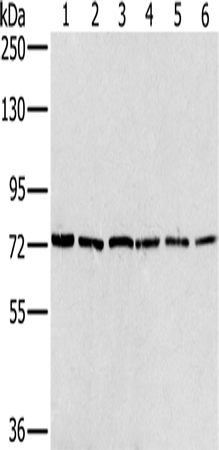
| WB | 咨询技术 | Human,Mouse,Rat |
| IF | 咨询技术 | Human,Mouse,Rat |
| IHC | 咨询技术 | Human,Mouse,Rat |
| ICC | 技术咨询 | Human,Mouse,Rat |
| FCM | 咨询技术 | Human,Mouse,Rat |
| Elisa | 1/1000-1/2000 | Human,Mouse,Rat |
| Aliases | S171; C14orf41; c14_5527 |
| WB Predicted band size | 71 kDa |
| Host/Isotype | Rabbit IgG |
| Antibody Type | Primary antibody |
| Storage | Store at 4°C short term. Aliquot and store at -20°C long term. Avoid freeze/thaw cycles. |
| Species Reactivity | Human, Mouse, Rat |
| Immunogen | Fusion protein of human NUMB |
| Formulation | Purified antibody in PBS with 0.05% sodium azide and 50% glycerol. |
+ +
以下是3-4条关于NUMB抗体的参考文献及其简要概括:
1. **"NUMB controls p53 tumor suppressor activity in breast cancer"**
*Authors: Colaluca, I. N., et al. (2008)*
**摘要**:该研究通过免疫沉淀和Western blot实验使用NUMB抗体,揭示了NUMB通过稳定p53蛋白抑制乳腺癌发展的分子机制,表明NUMB缺失会导致p53降解并促进肿瘤发生。
2. **"Asymmetric segregation of the tumor suppressor NUMB during cell division"**
*Authors: Santolini, E., et al. (2000)*
**摘要**:作者利用免疫荧光和特异性NUMB抗体,证明NUMB在细胞分裂中的不对称分布对神经前体细胞分化的调控至关重要,并阐明了其与Notch信号通路的相互作用。
3. **"NUMB is a key regulator of epidermal growth factor receptor endocytosis"**
*Authors: McGill, M. A., et al. (2009)*
**摘要**:通过免疫染色和功能实验,该研究显示NUMB抗体检测到其在内吞体中的定位,并证明NUMB通过调控EGFR内吞作用影响细胞信号传导和肿瘤生长抑制。
4. **"Loss of NUMB expression correlates with poor prognosis in colorectal cancer"**
*Authors: Wang, J., et al. (2015)*
**摘要**:利用免疫组化(IHC)和NUMB抗体分析结直肠癌组织样本,发现NUMB低表达与患者预后不良相关,提示其作为潜在生物标志物的价值。
这些文献覆盖了NUMB在肿瘤抑制、细胞分化、受体调控及临床预后中的功能研究,均通过NUMB抗体进行蛋白定位、表达水平或相互作用分析。
The NUMB protein, encoded by the *NUMB* gene, is a key regulator of cell fate determination, initially identified for its role in asymmetric cell division during development. It functions as a tumor suppressor by inhibiting Notch signaling, a pathway critical for cell differentiation and proliferation. NUMB achieves this through its phosphotyrosine-binding (PTB) domain, which mediates interactions with membrane receptors and intracellular partners, and its proline-rich region (PRR), involved in protein-protein interactions. Selective splicing generates multiple NUMB isoforms with distinct functional properties, further modulated by post-translational modifications like phosphorylation and ubiquitination.
NUMB antibodies are essential tools for studying its expression patterns, subcellular localization, and interactions in physiological and pathological contexts. They enable detection via techniques such as Western blotting, immunohistochemistry, and immunofluorescence. Dysregulation of NUMB has been linked to cancers (e.g., breast, lung), neurodegenerative diseases, and developmental disorders, making these antibodies vital for mechanistic research. Commercial NUMB antibodies vary in specificity, often targeting epitopes in conserved regions (e.g., PTB domain) or isoform-unique sequences. Validation across applications and species remains critical due to NUMB's structural complexity and cross-reactivity risks. Recent studies also highlight NUMB's role in endocytosis, cell polarity, and stem cell maintenance, expanding its relevance in biomedical research.
×